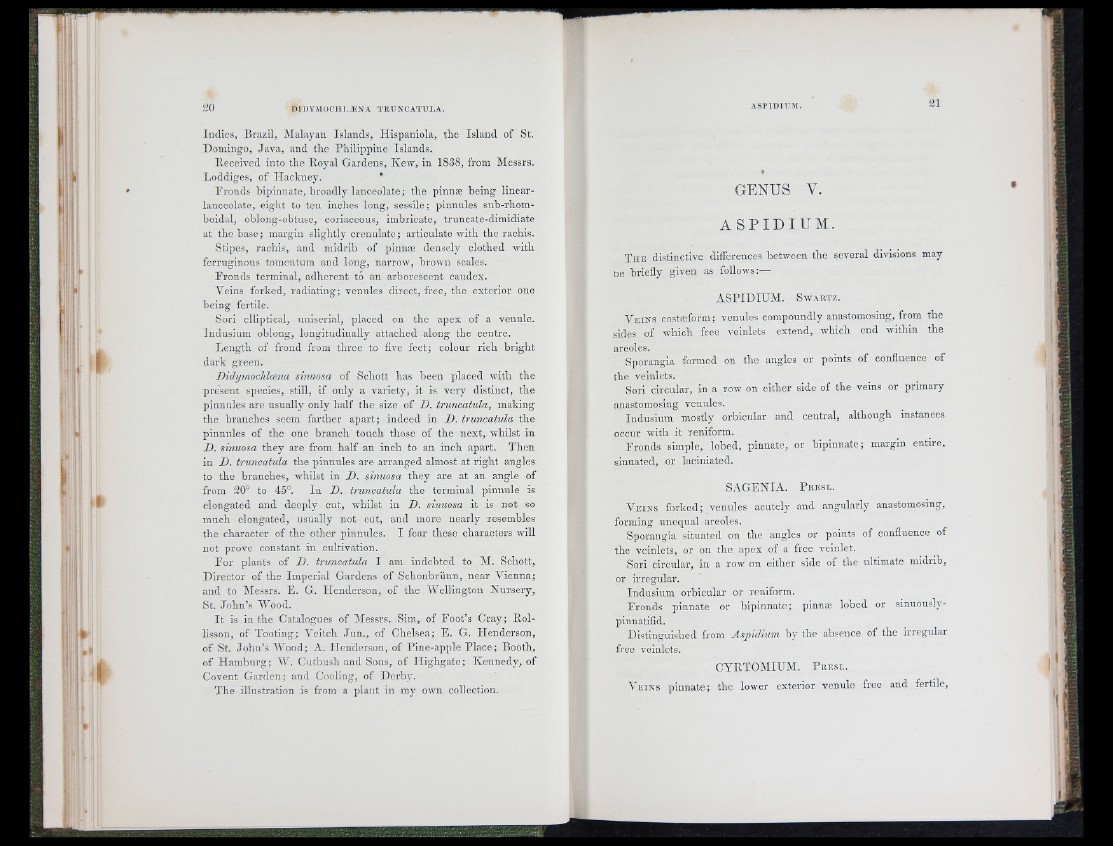
Indies, Ilnizil, Malayan Islands, Hispaniola, tlie Island of St.
Domingo, Java, and the Philippine Islands.
Received into the Royal Gardens, Keiv, in 1838, from Messrs.
Loddiges, of Hackney. ’
Fronds bipinnate, broadly lanceolate; the pinn» being linear-
lanceolatc, eight to ten inches long, sessile; pinnules sub-rhom-
boidal, oblong-obtuse, coriaceous, imbricate, truncate-dimidiate
at the base; margin slightly creiiulate; articulate with the rachis.
Stipes, rachis, and midrib of pinn» densely clothed with
ferruginous tomeutum and long, narrow, brown scales.
Fronds terminal, adherent to an arborescent caudex.
Veins forked, radiating; venules direct, free, the exterior one
being fertile.
Sori elliptical, uuiserial, placed on the apex of a venule.
Indusium oblong, longitudinally attached along the centre.
Length of frond from three to five feet; colour rich bright
dark green.
DidymochlcBna sinuosa of Schott has been placed with the
present species, still, if only a variety, it is very distinct, the
pinnules are usually only half the size of D. truncatula, making
the branches seem farther apart; indeed in D. truncatula the
pinnules of the one branch touch those of the next, whilst in
D. sinuosa they are from half an inch to an inch apart. Then
in D. truncatula the pinnules are arranged almost at right angles
to the branches, -whilst in D. sinuosa they are at an angle of
from 20° to 45°. In D. truncatula the terminal pinnule is
elongated and deeply cut, whilst in D. sinuosa it is not so
much elongated, usually not cut, and more nearly resembles
the character of the other pinnules. I fear these characters will
not prove constant in cultivation.
For plants of D. truncatula I am indebted to M. Schott,
Director of the Imperial Gardens of Schonhrünn, near Vienna;
and to Messrs. E. G. Flenderson, of the Wellington Nursery,
St. Jo h n ’s Wood.
I t is in the Catalogues of Messrs. Sim, of Foot’s Cray; Rol-
lisson, of Tooting; Veitch Ju n ., of Chelsea; E. G. Henderson,
of St. John’s Wood; A. Henderson, of Pine-apple Place; Booth,
of Hamburg; W. Cutbush and Sons, of Highgate; Kennedy, of
Covent Garden; and Cooling, of Derby.
The illustration is from a plant in my own collection.
GENUS V.
A S PI D I U M .
T h e d i s t in c t iv e d if f e rc n o e s b e tw e e n th e s e v e r a l d iv i s io n s m a y
De b r i e f ly g iv e n a s f o llo w s :—
AS P ID IUM . S w a r t z .
V e in s c o s t» f o rm ; v e n u l e s c o m p o u n d ly a n a s tom o s in g , f r om t h e
s id e s o f w h i c h f r e e v e i n l e t s e x t e n d , w h i c h e n d w i th i n th e
a re o le s .
Sporangia formed on the angles or points of confluence of
the veinlets.
Sori circular, in a row on either side of the veins or primary
anastomosing venules.
Indusium mostly orbicular and central, although instances
occur with it reniform.
Fronds simple, lobed, pinnate, or bipinnate; margin entire,
sinuated, or lacinlated.
SAGENIA. P r e s l .
V e in s f o r k e d ; v e n u l e s a c u t e ly a n d a n g u l a r ly a n a s tom o s in g ,
f o rm in g u n e q u a l a r e o l e s .
Sporangia situated on the angles or points of confluence of
the veinlets, or on the apex of a free veinlet.
Sori circular, in a row on either side of the ultimate midrib,
or irregular.
Indusium orbicular or reniform.
Fronds pinnate or bipinnate; pinn» lobed or sinuously-
pinnatifid.
Distinguished from Aspidium by the absence of the irregular
free veinlets.
CYRTOIMIUM. P r e s l .
V e in s p i n n a t e ; t h e lo w e r e x t e r io r v e n u l e f r e e a n d f e r t i l e .